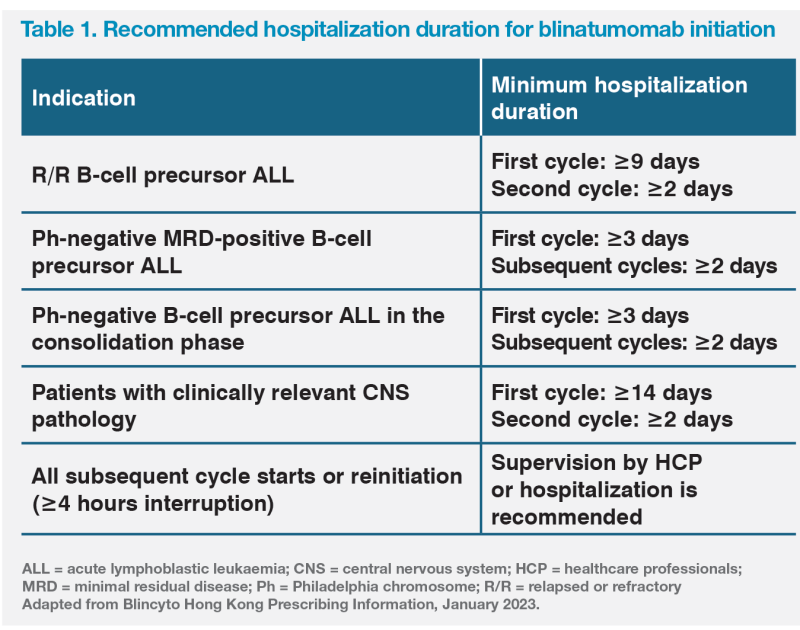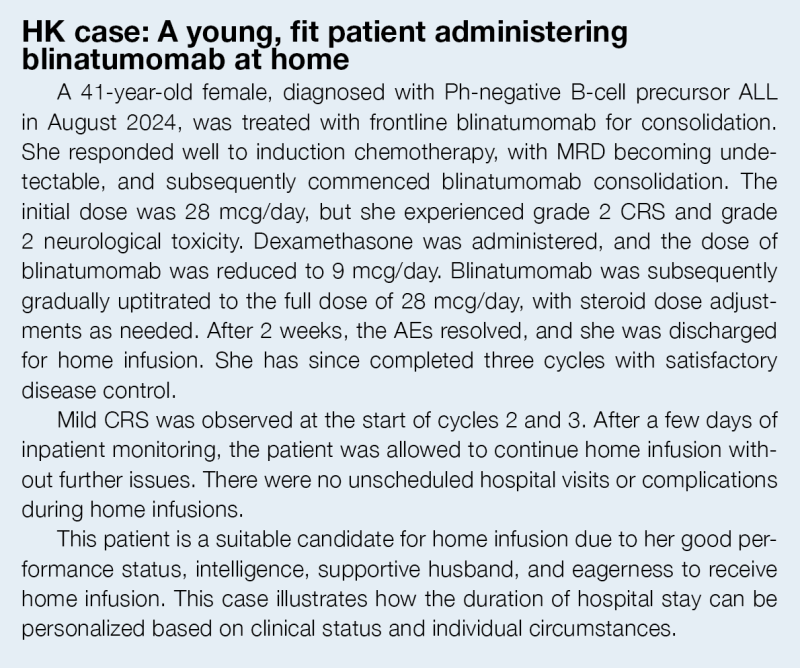Blinatumomab for B-cell precursor ALL: From hospital to home









Blinatumomab, a bispecific T cell–engager antibody administered as a continuous intravenous (IV) infusion, has several indications in B-cell precursor acute lymphoblastic leukaemia (ALL). Traditionally, in Hong Kong, patients receiving blinatumomab are hospitalized for 28-day treatment cycles. In an interview with MIMS Oncology, Dr Carol Cheung, Specialist in Haematology & Haematological Oncology, and clinical pharmacist Ms Kitty Leung shared insights into how a proactive outpatient infusion protocol at a local hospital has enabled patients to receive blinatumomab at home. They discussed how home infusion of blinatumomab works, along with its risks, challenges, and benefits for both patients and healthcare providers.
Evolving role of blinatumomab in ALL
“Blinatumomab has been available in Hong Kong for nearly a decade and has profoundly transformed the treatment landscape of ALL. Initially approved for relapsed or refractory [R/R] cases, its role has since expanded to include minimal residual disease [MRD]– positive disease and, more recently, it has become part of frontline consolidation therapy. This versatility highlights its relevance across various treatment settings. Even in MRD-negative patients, frontline use of blinatumomab has been shown to improve survival outcomes,” noted Cheung. “Furthermore, in Philadelphia chromosome [Ph]–positive ALL, there is a growing trend toward potentially eliminating chemotherapy altogether by incorporating blinatumomab. For Ph-negative cases, combining multiagent chemotherapy with blinatumomab as initial therapy has demonstrated remarkable efficacy.” [Blincyto Hong Kong Prescribing Information, January 2023; N Engl J Med 2024;391:320-333; J Clin Med 2025;14:2055]
Continuous IV infusion: The need for outpatient options
Blinatumomab is administered via continuous IV infusion over 4 weeks (28 days), followed by a 14-day break, forming a 42-day treatment cycle. The total number of cycles is determined by the treating physician, based on indication. Infusion should be initiated under the supervision of experienced clinicians. Hospitalization is generally required for treatment initiation and for subsequent cycles, with the length of hospital stay depending on indication. (Table 1) [Blincyto Hong Kong Prescribing Information, January 2023]

“In Hong Kong, the usual practice has been to hospitalize patients for the entire 28-day treatment cycle due to its inconvenient mode of administration,” Cheung remarked. “This approach, repeated with each cycle, is resource-intensive and burdensome for patients and caregivers, requiring long stays and frequent visits. It creates logistical and emotional challenges, highlighting the need for alternative delivery methods to improve patient comfort and reduce strain on healthcare resources.”
“Therefore, we have introduced an outpatient infusion programme, allowing patients to receive blinatumomab at home once their condition is stable,” Cheung added.
Home infusion of blinatumomab: How does it work?
Patient eligibility
“Firstly, we identify patients suitable for home infusion. They should be fit adults with good performance status, supportive caregivers, and a strong motivation for home infusion,” noted Cheung. “Generally, we select stable patients with a low risk of developing cytokine release syndrome [CRS]. These patients should live close to the hospital or be able to reach it quickly in case of emergency. Patients and their caregivers need a basic understanding of how to manage outpatient infusion and the ability to operate and care for the pump after education. Motivation and willingness are key.”
“Conversely, patients on other IV medications, such as antibiotics, or those with abnormal baseline blood counts, significant concerns about home infusion, or a high risk of developing CRS are generally not suitable. Ultimately, patient safety and their preference are our top considerations,” she continued.
Timing for transition
“In adult patients, hospitalization for ≥9 days during the first cycle is recommended for R/R ALL. In other settings, shorter durations are often sufficient,” said Cheung. (Table 1) “The initial hospital stay is crucial, even when outpatient treatment is planned, as it allows close monitoring of adverse events [AEs], especially during the initial phase of the first cycle, when conditions like CRS or neurological toxicity are most likely to occur,” she explained. “To ensure safety, we usually keep patients in-hospital for close monitoring during this period.”
“If clinically relevant AEs occur and treatment is interrupted at any point, blinatumomab should be restarted at 9 mcg/day. We typically monitor patients closely for ≥7 days until they reach the full dose of 28 mcg/day and show no signs of recurring toxicity before discharge,” Cheung continued.
“Hospital stays also offer patients the opportunity to receive training via videos, demonstrations and hands-on practice in managing the infusion pump and responding to potential issues,” Cheung added. “The frontline healthcare team must ensure that patients are confident and competent in handling the pump and recognizing warning signs before authorizing discharge.”
“Generally, if the first cycle is tolerated well without significant AEs, a patient is less likely to encounter major issues in subsequent cycles. These patients may require only 2–3 days of hospitalization for the second and later cycles, and some stable patients may even go home after 1–2 days. This timing is highlyindividualized depending on each patient’s condition and ability to manage the treatment safely,” she shared.
Delivering blinatumomab at home
“When a patient’s condition is stable, treatment can be continued at home using a small, portable IV infusion pump and an admixed infusion bag containing blinatumomab, reconstituted by a pharmacist in aseptic conditions,” Leung and Cheung explained. “Infusion bags are available for 7-day [1-week] infusion, as well as 1-day [24-hour], 2-day [48-hour], 3-day [72-hour] and 4-day [96-hour] infusions.”
“In our practice, we usually dispense the 7-day infusion bags for outpatient use. The drug in the infusion bag is delivered via the ambulatory pump at a constant, preset flow rate that cannot be modified by anyone except the supplier,” Leung continued. “The pump is programmable, lockable, non-elastomeric, and equipped with an alarm that alerts if drug delivery is interrupted.”
Patient education and supplies
“Before discharge, patients receive training via videos and demonstrations during hospitalization. They practice operating the ambulatory pump with their 7-day infusion bag to build confidence,” said Cheung. “Trained nurses then complete a checklist to ensure patients can manage
home infusion independently. Patients are also provided with a booklet containing instructions, a diary, and frequently asked questions for troubleshooting. They use the diary to record daily body temperature and perform handwriting assessments, such as writing their home address, to monitor for drug-related toxicity. They are also encouraged to note alarms or unusual symptoms to discuss with their healthcare team during their next hospital visit.”
Tables 2 and 3 list detailed reminders on daily management and when to seek medical assistance.


“Each patient receives a purposefully designed backpack to carry the infusion bag while commuting, along with an extra battery for the infusion pump and a power cord for use between visits. A spillage kit is also provided in case of drug leakage, and a double clamp is provided for the infusion line,” Leung added.
Safety monitoring and management
“Fever is a common sign of CRS, occurring in more than half of our patients receiving blinatumomab. Neurological toxicity is also frequently observed,” Cheung remarked. “Premedication with steroids, such as dexamethasone, administered 1 hour before each cycle, can help prevent these toxicities. Patients with high tumour burden are considered high-risk and have an increased likelihood of CRS and neurological side effects. In such cases, cytoreduction prior to starting blinatumomab may be necessary. A step-up dosing regimen, beginning at 9 mcg/ day and escalating to 28 mcg/day after 7 days, along with premedication before each escalation, may also mitigate the risk of toxicity.” [Blincyto Hong Kong Prescribing Information, January 2023]
“During hospitalization, vital signs should be monitored very closely during the initial days of treatment to detect early signs of CRS. Blood tests are performed 3–4 times daily to check for markers of tumour lysis syndrome, liver and renal function, haematological parameters, and coagulation profile. Patients should perform daily handwriting assessments to monitor for any signs of neurological toxicity. Blood oxygen levels should also be regularly checked,” Cheung highlighted.
“If CRS or neurological toxicity occurs during treatment, management should follow international guidelines. For low-grade fever, observation and symptomatic relief are typically sufficient. However, if a patient develops high-grade fever, with or without haemodynamic instability or increased oxygen requirements, steroids are indicated,” Cheung advised. “Treatment may be interrupted if a patient experiences grade ≥3 clinically relevant AEs. Re-premedication is recommended before resuming blinatumomab after an interruption >4 hours.”
Potential risks and challenges
Logistics and supply
“Reconstitution of blinatumomab is performed after pharmacists receive a drug order from nurses in the ward. Since the shelf life of the reconstituted drug is limited under room temperature, minimizing the time between reconstitution and administration is essential to prevent treatment delays and reduce drug wastage. Therefore, effective communication between nursing staff and pharmacists is crucial,” emphasized Leung.
Bag preparation and priming
“Pharmacists use specific techniques and follow procedures outlined in the prescribing information to prepare the 7-day infusion bags. The stabilizer and saline are combined in an empty bag and gently swirled—avoiding vigorous shaking — before adding the reconstituted drug. It is also important that the pump cassettes and IV tubing are compatible: the IV tubing must be polyolefin, diethylhexylphthalate [DEHP]-free polyvinyl chloride [PVC] or ethylene vinyl acetate [EVA],” pointed out Leung. “The IV line must be primed with the prepared solution by trained nursing staff. Each 7-day bag contains about 9 mL of excess volume to allow for the priming.” [www.Blincytohcp.com/dosing/preparation]
Risk of drug interruptions
“Drug interruptions are particularly concerning, given the high cost and short shelf life of blinatumomab, as well as the potential need for re-priming, which can cause drug shortfalls on the 7th day due to insufficient excess volume,” noted Cheung. “Therefore, re-priming should be limited. Selecting stable patients with a low risk of developing CRS is essential to minimize the risk of interruptions.”
Drug delivery when volume is low
“Due to limited excess volume, the pump may encounter difficulties at the end of the 7-day regimen, such as drug shortfalls from re-priming or air bubbles in the tubing, leading to frequent alarms or the need for tubing tapping,” Leung noted. “In most cases, scheduled bag replacements are timed carefully to minimize such issues.”
Other technical issues and troubleshooting
“The pump alarm indicates technical issues, such as air bubbles in the tubing or flow irregularity. Patients can follow troubleshooting instructions, such as gently tapping the tubing if air bubbles or flow irregularities trigger the alarm, to resolve these minor problems, advised Leung, “If issues persist, they should return to the hospital promptly to seek help from nursing staff.”
Real-world experience
“In our hospital, approximately 60–70 percent of blinatumomab infusion cases are managed as outpatients. Over the past 2 years, >20 cycles have been successfully administered in outpatient setting. Few minor issues were encountered, mainly air bubbles or tubing problems, which were promptly resolved by trained nursing staff. During this period, only one patient sought medical attention for fever during home infusion,” shared Cheung.
“Our frontline nursing team plays a vital role as the primary contact for patients experiencing infusion issues at home. Patients can call immediately whenever issues arise, and their concerns are triaged for further management.”
“Overall, patients are highly satisfied with staying at home for infusions. The approach is highly personalized — some patients continue with hospital stays, while others have 7-day home infusions or shorter 24- or 48-hour in-hospital infusions before transitioning to the 7-day home-based regimen. This flexibility allows our patients to receive the regimen that is most suitable for their needs,” Cheung concluded.
